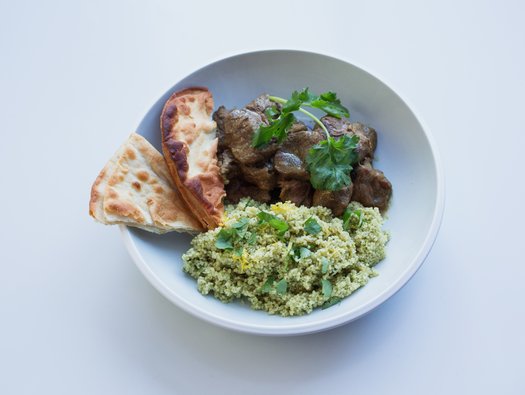Moroccan lamb tagine with lemon couscous

Serving this North African dish with couscous keeps it low in potassium. As lamb is higher in fat, we have suggested to serve this recipe for a special occasion rather than every day.

Serving this North African dish with couscous keeps it low in potassium. As lamb is higher in fat, we have suggested to serve this recipe for a special occasion rather than every day.
600g shoulder of lamb, diced
½ teaspoon ground cinnamon
½ teaspoon ground ginger
½ teaspoon ground coriander
½ teaspoon turmeric
3 tablespoon water
1 teaspoon ground black pepper
2 tablespoon olive oil
1 onion
1 garlic clove
300ml low salt vegetable stock
1 tablespoon honey
300ml boiling water
200g couscous
Zest and juice of ½ lemon
50ml olive oil
1 tablespoon fresh flat leaf parsley
1 tablespoon fresh coriander
Pinch freshly ground black pepper
Alternatively, serve with flatbread instead of couscous.
Mix the black pepper, cinnamon, ginger, coriander and turmeric with 3 tablespoons of water to make a marinade for the lamb. Coat the lamb in the marinade, cover with cling film and rest in the fridge for at least 1 hour.
Strain the lamb and cook until brown with a little oil in frying pan then move to saucepan. Dice the onion and garlic and cook in the frying pan until soft then add to saucepan. Deglaze the frying pan by adding a little stock and stirring. Pour, along with the remaining stock and marinade into the saucepan.
Bring to the boil, cover, and simmer for approximately 1 ½ hours or until the lamb is meltingly tender but still holding its shape. Uncover the saucepan for the final 10 minutes to reduce and thicken the sauce as required and add the honey.
Pour the couscous into a large saucepan and cover with boiling water. Stir in the lemon zest and set aside until the grains have swollen. Turn on a low heat, add the olive oil and lemon juice and cook for 2 minutes, stirring with a fork to fluff up the grains. Stir in the chopped herbs and pepper before serving.
The main source of carbohydrate in this dish is the couscous. The carbohydrate values have been provided for those who have trained in insulin adjustment.
This recipe is low in potassium and therefore can be enjoyed in the quantities suggested as part of a low potassium diet.
This dish does contain phosphate so If you have been prescribed a phosphate binder ensure you take them with this meal.
This dish is high in protein which makes it suitable for those receiving dialysis. If you want to reduce the amount of protein, reduce the amount of lamb or make the dish with a 50:50 ratio with the vegetarian alternative.
Use a gluten-free vegetable stock. Couscous is not suitable for a gluten free diet so serve with rice or gluten-free flatbread.
Replace the lamb with 400g chickpeas and 400g green lentils.
Omit the honey and use maple syrup. Replace the lamb with 400g chickpeas and 400g green lentils.
You can serve this dish with couscous or a flatbread. Adding a small portion of vegetables will make this a more balanced meal. As this recipe is low in potassium, boiled broccoli or green beans would be a suitable option.
To save money, look for frozen diced lamb or try the vegetarian option. You can use a teaspoon of dried herbs instead of fresh.
Allow to cool then place in an airtight container and refrigerate, consume within two days. This is suitable for freezing, just place in a sealed container and defrost before reheating. Ensure the food is piping hot before serving.
By giving us your email address, you're giving us permission to send you the latest news from Kidney Care UK. Further information about how we protect and use your personal data is available in our Privacy policy. If you would like to change the way we communicate with you at any time please email [email protected]. You can unsubscribe at any time by using the link at the bottom of every email we send.